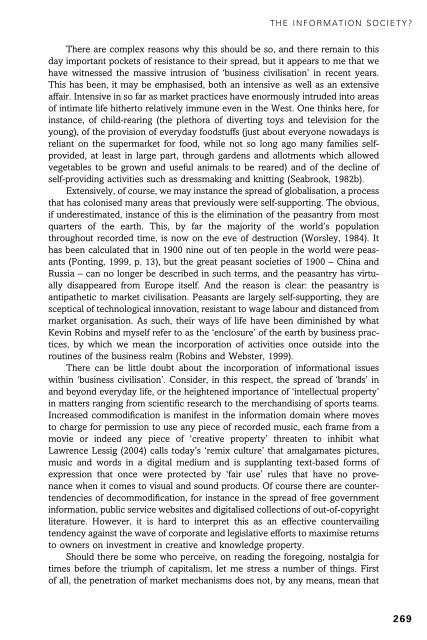Theories of the Information Society, Third Edition - Cryptome
Theories of the Information Society, Third Edition - Cryptome
Theories of the Information Society, Third Edition - Cryptome
You also want an ePaper? Increase the reach of your titles
YUMPU automatically turns print PDFs into web optimized ePapers that Google loves.
THE INFORMATION SOCIETY?<br />
1<br />
1<br />
1<br />
2<br />
1<br />
1<br />
There are complex reasons why this should be so, and <strong>the</strong>re remain to this<br />
day important pockets <strong>of</strong> resistance to <strong>the</strong>ir spread, but it appears to me that we<br />
have witnessed <strong>the</strong> massive intrusion <strong>of</strong> ‘business civilisation’ in recent years.<br />
This has been, it may be emphasised, both an intensive as well as an extensive<br />
affair. Intensive in so far as market practices have enormously intruded into areas<br />
<strong>of</strong> intimate life hi<strong>the</strong>rto relatively immune even in <strong>the</strong> West. One thinks here, for<br />
instance, <strong>of</strong> child-rearing (<strong>the</strong> plethora <strong>of</strong> diverting toys and television for <strong>the</strong><br />
young), <strong>of</strong> <strong>the</strong> provision <strong>of</strong> everyday foodstuffs (just about everyone nowadays is<br />
reliant on <strong>the</strong> supermarket for food, while not so long ago many families selfprovided,<br />
at least in large part, through gardens and allotments which allowed<br />
vegetables to be grown and useful animals to be reared) and <strong>of</strong> <strong>the</strong> decline <strong>of</strong><br />
self-providing activities such as dressmaking and knitting (Seabrook, 1982b).<br />
Extensively, <strong>of</strong> course, we may instance <strong>the</strong> spread <strong>of</strong> globalisation, a process<br />
that has colonised many areas that previously were self-supporting. The obvious,<br />
if underestimated, instance <strong>of</strong> this is <strong>the</strong> elimination <strong>of</strong> <strong>the</strong> peasantry from most<br />
quarters <strong>of</strong> <strong>the</strong> earth. This, by far <strong>the</strong> majority <strong>of</strong> <strong>the</strong> world’s population<br />
throughout recorded time, is now on <strong>the</strong> eve <strong>of</strong> destruction (Worsley, 1984). It<br />
has been calculated that in 1900 nine out <strong>of</strong> ten people in <strong>the</strong> world were peasants<br />
(Ponting, 1999, p. 13), but <strong>the</strong> great peasant societies <strong>of</strong> 1900 – China and<br />
Russia – can no longer be described in such terms, and <strong>the</strong> peasantry has virtually<br />
disappeared from Europe itself. And <strong>the</strong> reason is clear: <strong>the</strong> peasantry is<br />
antipa<strong>the</strong>tic to market civilisation. Peasants are largely self-supporting, <strong>the</strong>y are<br />
sceptical <strong>of</strong> technological innovation, resistant to wage labour and distanced from<br />
market organisation. As such, <strong>the</strong>ir ways <strong>of</strong> life have been diminished by what<br />
Kevin Robins and myself refer to as <strong>the</strong> ‘enclosure’ <strong>of</strong> <strong>the</strong> earth by business practices,<br />
by which we mean <strong>the</strong> incorporation <strong>of</strong> activities once outside into <strong>the</strong><br />
routines <strong>of</strong> <strong>the</strong> business realm (Robins and Webster, 1999).<br />
There can be little doubt about <strong>the</strong> incorporation <strong>of</strong> informational issues<br />
within ‘business civilisation’. Consider, in this respect, <strong>the</strong> spread <strong>of</strong> ‘brands’ in<br />
and beyond everyday life, or <strong>the</strong> heightened importance <strong>of</strong> ‘intellectual property’<br />
in matters ranging from scientific research to <strong>the</strong> merchandising <strong>of</strong> sports teams.<br />
Increased commodification is manifest in <strong>the</strong> information domain where moves<br />
to charge for permission to use any piece <strong>of</strong> recorded music, each frame from a<br />
movie or indeed any piece <strong>of</strong> ‘creative property’ threaten to inhibit what<br />
Lawrence Lessig (2004) calls today’s ‘remix culture’ that amalgamates pictures,<br />
music and words in a digital medium and is supplanting text-based forms <strong>of</strong><br />
expression that once were protected by ‘fair use’ rules that have no provenance<br />
when it comes to visual and sound products. Of course <strong>the</strong>re are countertendencies<br />
<strong>of</strong> decommodification, for instance in <strong>the</strong> spread <strong>of</strong> free government<br />
information, public service websites and digitalised collections <strong>of</strong> out-<strong>of</strong>-copyright<br />
literature. However, it is hard to interpret this as an effective countervailing<br />
tendency against <strong>the</strong> wave <strong>of</strong> corporate and legislative efforts to maximise returns<br />
to owners on investment in creative and knowledge property.<br />
Should <strong>the</strong>re be some who perceive, on reading <strong>the</strong> foregoing, nostalgia for<br />
times before <strong>the</strong> triumph <strong>of</strong> capitalism, let me stress a number <strong>of</strong> things. First<br />
<strong>of</strong> all, <strong>the</strong> penetration <strong>of</strong> market mechanisms does not, by any means, mean that<br />
269
















